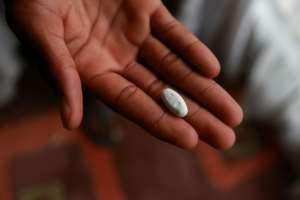
The colour Red in Ghana’s national flag symbolizes the blood of our forefathers. Those who fought for independence and self-determination. But today, Red has taken on a new and devastating meaning among Ghana’s youth. Thus, a lethal street drug combination is wrecking lives and threatening Ghana’s future. The irony could not be more tragic.
Across cities, ghettos, and even secondary schools, young people are abusing a drug dubbed “Red”. A dangerous blend of tapentadol (a potent opioid) and carisoprodol (a muscle relaxant) is often crushed into drinks or snorted. Its appeal is cheap, but its effect is fatal. Therefore, it is not just a health crisis but a civic emergency which demands a civic response, one that uses film not as escape, but as intervention. The scale of the problem is chilling. For instance, according to data from the Ministry of Youth and Sports, drug abuse among Ghanaian youth has escalated in the last five years, with the Red pandemic now taking center stage. Also, in the Ashanti, Greater Accra, Eastern and Western regions, community health workers and educators report a disturbing rise in drug-related absenteeism, mental breakdowns, and gang violence.
Explicitly, a report by the Ghana Education Service (GES) and, Food and Drugs Board Authority (FDA) revealed that over 60% of drug cases among the youth and in Senior High School were linked to tramadol, opioids and prescription drugs, with many students unaware of what they were consuming. In March 2025, the Ministry of Youth, supported by the Food and Drugs Authority (FDA), launched the “Ghana Against Drugs – Red Means Stop” campaign. It combines sensitization, rehabilitation, and media advocacy. Regardless of the efforts, the pandemic spreads faster than flyers can be distributed or workshops conducted. The truth is, the fight against “Red” cannot be won by pamphlets alone; therefore, it must be won with a story.
As a writer, teaching and research assistant, and cultural critic, my work interrogates how film can function as more than entertainment. I believe film is Ghana’s most underused civic tool. Significantly, it has the power to dramatize, educate, and mobilize public action, especially among the youth. This crisis demands that we tap into that power. Actors ready, camera-ready, light-ready, sound-ready. Three, two, one, action………Imagine a gripping short film following a teenage boy in a marginalized community, drawn into the allure of Red to keep up in the hustle, only to spiral into addiction. Imagine his redemption coming not through police arrest, but through peer-led intervention. Now imagine that film screened in schools, community halls, and on social media, not once, but routinely, as part of our civic education arsenal. This is not fiction, but a national survival strategy.
What Film Can Do That Flyers Cannot. Visual storytelling breaks literacy barriers. Many of the youth most at risk are outside formal education systems or cannot engage in academic content. Film activates emotion, not just instruction. It inspires identification with characters, shame, fear, and hope, turning lessons into lived experience. With mobile cinema vans, YouTube, TikTok, and
local TV, film can reach where workshops and police patrols cannot. In short, films can turn statistics into stories, and stories into action.
For instance, across Africa and the Global South, countries are turning to cinema to counter drug epidemics. Nigeria’s Sweet Sweet Codeine, a BBC Africa Eye documentary, exposed the codeine addiction crisis and triggered a nationwide crackdown, policy reform, and public outrage. India’s regional anti-opioid dramas, aired on village networks, have led to increased rehabilitation rates and political pressure for enforcement. South Africa’s educational docuseries are now used in over 500 schools to teach about substance abuse, domestic violence, and civic rights. Ghana has the creative talent; however, what we lack is the state and institutional vision to support it.
What the State Must Do Now. This is not a time for slogans; Ghana needs a strategic cultural investment to mobilize film as a developmental force. (i) Establish a National Civic Film Fund under the joint oversight of the Ministry of Youth, the Ministry of Health, the Food and Drugs Authority, and the National Film Authority. (ii) Commission short films, docu-dramas, and animations on drug abuse, peer pressure, and community resilience. (iii) Integrate anti-drug cinema into the Ghana Education Service Life Skills and Civic Education curricula at all basic and secondary levels. (iv) Partner with filmmakers, influencers, and rehabilitation centers to create Red Resistance storytelling projects. (iv) Use community cinema vans to tour high-risk zones with educational screenings and facilitated group discussions.
Ghana must not allow the most sacred symbol in the national flag to be hijacked by addiction. Red should remind us of sacrifice, not overdose. Red should symbolize resistance, not retreat. Ghana should use the camera lens as a counterforce to the syringe and the pill. Ghana’s youth are not lost; they are simply unheard. Through film, Ghana can hear them, reach them and save them. Ghana is at a crossroads. The Red crisis is a test not just of our law enforcement or health system, but of our imagination. It challenges us to think bigger, to act smarter, and to tell our own stories before someone else tells them for us. This is not just my vision as a writer. It is my patriotic duty as a Ghanaian. Thus, film can be our shield and our sword. It is time we used it.
Bright Kwadwo Oduro is a teaching and research assistant and columnist dedicated to exploring film as a tool for education, policy engagement, and civic transformation. He writes the weekly series “Film as a Developmental Tool in Ghana.


